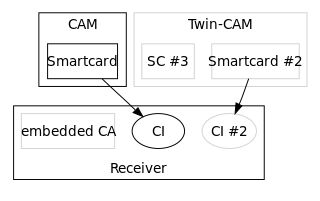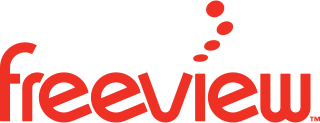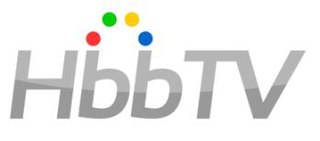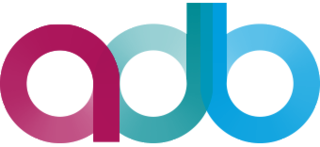
Digital Video Broadcasting (DVB) is a set of international open standards for digital television. DVB standards are maintained by the DVB Project, an international industry consortium, and are published by a Joint Technical Committee (JTC) of the European Telecommunications Standards Institute (ETSI), European Committee for Electrotechnical Standardization (CENELEC) and European Broadcasting Union (EBU).
MHEG-5, or ISO/IEC 13522-5, is part of a set of international standards relating to the presentation of multimedia information, standardised by the Multimedia and Hypermedia Experts Group (MHEG). It is most commonly used as a language to describe interactive television services.

Interactive television is a form of media convergence, adding data services to traditional television technology. It has included on-demand delivery of content, online shopping, and viewer polls. Interactive TV is an example of how new information technology can be integrated vertically into established technologies and commercial structures.
Digital terrestrial television is a technology for terrestrial television in which land-based (terrestrial) television stations broadcast television content by radio waves to televisions in consumers' residences in a digital format. DTTV is a major technological advance over the previous analog television, and has largely replaced analog which had been in common use since the middle of the 20th century. Test broadcasts began in 1998 with the changeover to DTTV beginning in 2006 and is now complete in many countries. The advantages of digital terrestrial television are similar to those obtained by digitising platforms such as cable TV, satellite, and telecommunications: more efficient use of limited radio spectrum bandwidth, provision of more television channels than analog, better quality images, and potentially lower operating costs for broadcasters.
Datacasting is the broadcasting of data over a wide area via radio waves. It most often refers to supplemental information sent by television stations along with digital terrestrial television (DTT), but may also be applied to digital signals on analog TV or radio. It generally does not apply to data which is inherent to the medium, such as PSIP data which defines virtual channels for DTT or direct broadcast satellite systems; or to things like cable modem or satellite modem, which use a completely separate channel for data.

In Digital Video Broadcasting, the Common Interface is a technology which allows decryption of pay TV channels. Pay TV stations want to choose which encryption method to use. The Common Interface allows TV manufacturers to support many different pay TV stations, by allowing to plug in exchangeable conditional-access modules (CAM) for various encryption schemes.
Globally Executable MHP (GEM) is a DVB specification of a Java based middleware for TV broadcast receivers, IPTV terminals and Blu-ray players. GEM is an ETSI standard and an ITU "Recommendation”. GEM defines a set of common functionalities which are independent from the signaling and protocols of a specific transmission network and enables to write interoperable Java applications for TV. GEM is not intended to be directly implemented, but rather forms the basis for broader specifications targeting a particular network infrastructure or class of device. GEM defines profiles for different device classes (targets) – these define the set of available features of GEM for this device class. Currently GEM defines targets for broadcast, packaged media (Blu-Ray) and IPTV. Combinations of these targets can be combined into a hybrid GEM platform, which enables to build devices with multiple network interfaces, such as a combined broadcast/IPTV set-top box.
Freesat is a British free-to-air satellite television service, first formed as a joint venture between the BBC and ITV plc and now owned by Digital UK. The service was formed as a memorandum in 2007 and has been marketed since 6 May 2008. Freesat offers a satellite alternative to the Freeview service on digital terrestrial television, with a broadly similar selection of channels available without subscription for users purchasing a receiver.
The OpenCable Application Platform, or OCAP, is an operating system layer designed for consumer electronics that connect to a cable television system, the Java-based middleware portion of the platform. Unlike operating systems on a personal computer, the cable company controls what OCAP programs run on the consumer's machine. Designed by CableLabs for the cable networks of North America, OCAP programs are intended for interactive services such as eCommerce, online banking, Electronic program guides, and digital video recording. Cable companies have required OCAP as part of the Cablecard 2.0 specification, a proposal that is controversial and has not been approved by the Federal Communications Commission. Cable companies have stated that two-way communications by third party devices on their networks will require them to support OCAP. The Consumer Electronics Association and other groups argue OCAP is intended to block features that compete with cable company provided services and that consumers should be entitled to add, delete and otherwise control programs as on their personal computers. On January 8, 2008 CableLabs announced the Tru2Way brand for the OpenCable platform, including OCAP as the application platform.
ISDB-T International, or SBTVD, short for Sistema Brasileiro de Televisão Digital, is a technical standard for digital television broadcast used in Brazil, Argentina, Peru, Botswana, Chile, Honduras, Venezuela, Ecuador, Costa Rica, Paraguay, Philippines, Bolivia, Nicaragua, El Salvador and Uruguay, based on the Japanese ISDB-T standard. ISDB-T International launched into commercial operation on 2 December 2007, in São Paulo, Brazil, as SBTVD.

Freeview is New Zealand's free-to-air television platform. It is operated by a joint venture between the country's major free-to-air broadcasters – government-owned Television New Zealand and Radio New Zealand, government-subsidised Whakaata Māori, and the American-owned Warner Bros. Discovery.
BD-J, or Blu-ray Disc Java, is a specification supporting Java ME Xlets for advanced content on Blu-ray Disc and the Packaged Media profile of Globally Executable MHP (GEM).
IP over DVB implies that Internet Protocol datagrams are distributed using some digital television system, for example DVB-H, DVB-T, DVB-S, DVB-C or their successors like DVB-S2. This may take the form of IP over MPEG, where the datagrams are transferred over the MPEG transport stream, or the datagrams may be carried in the DVB baseband frames directly, as in GSE.
Interactive television standards are standards for television broadcasting that relate to different modes of interaction and feedback mechanisms. This interaction system is what creates the television experience.

DigitAlb is an Albanian media, digital satellite and terrestrial TV platform based in Tirana, Albania. The TV platform began terrestrial broadcasts in July 2004, and satellite broadcasts by the end of that year. At the same time, DigitAlb began broadcasting some channels of defunct AlbaniaSat's satellite platform SAT + which eventually went bankrupt. DigitAlb closely collaborates with absorbing sports package SuperSport while having introduced wireless DVB-H technology for wireless TV for the first time in Albania since 2006.

Freeview is the brand name of the digital terrestrial television platform in Australia intended to bring all of free-to-air (FTA) broadcasters onto a consistent marketing platform, to compete against subscription television, in particular Foxtel. The strategy coincided with the expansion to 3 digital channels for each FTA network and the planned phasing out of analog television in Australia. Important services from Freeview include its free-to-air channels with an enhanced EPG across all channels. Freeview also certifies televisions, set-top boxes and personal video recorders (PVR) which meet its standards.

Hybrid Broadcast Broadband TV (HbbTV) is both an industry standard and promotional initiative for hybrid digital TV to harmonise the broadcast, Internet Protocol Television (IPTV), and broadband delivery of entertainment to the end consumer through connected TVs and set-top boxes. The HbbTV Association, comprising digital broadcasting and Internet industry companies, has established a standard for the delivery of broadcast TV and broadband TV to the home, through a single user interface, creating an open platform as an alternative to proprietary technologies. Products and services using the HbbTV standard can operate over different broadcasting technologies, such as satellite, cable, or terrestrial networks.

Advanced Digital Broadcast (ADB) is a company which provides software, system and services to pay-TV and telecommunication operators, content distributors and property owners around the world. The company specializes also in the development of digital connectivity devices such as set-top boxes and residential gateways.
DVB-RCT, provides a method by which the DVB-T platform can become a bi-directional, asymmetric, data path using wireless between broadcasters and customers. DVB-T when completed with DVB-RCT can be used not only for Interactive TV, but also for light IP telecommunication services. Various degrees of interactivity could be offered, without implying any return channel back from the user to the service provider: data carrousel or Electronic Programs Guides (EPG) are examples of such enhanced TV services which make use of “Local Interactivity”, without any return path from customer to provider. To implement new interactive services having a closely coupled and real-time relationship with the TV programs, a low latency return channel technology is mandatory, and this is the goal of the DVB-RCT. Without adding a cellular style network with about x20 more masts no Internet usage except about 1/20th speed of analogue dialup would be feasible.








